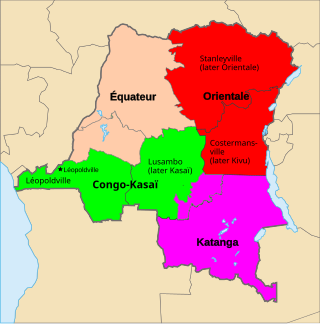
Katanga was one of the four large provinces created in the Belgian Congo in 1914. It was one of the eleven provinces of the Democratic Republic of the Congo between 1966 and 2015, when it was split into the Tanganyika, Haut-Lomami, Lualaba, and Haut-Katanga provinces. Between 1971 and 1997, its official name was Shaba Province.

Kinshasa, formerly named Léopoldville before 1966, is the capital and largest city of the Democratic Republic of the Congo. Once a site of fishing and trading villages along the Congo River, Kinshasa is now one of the world's fastest-growing megacities. With an estimated population of 16 million residents, it's the most densely populated city in the DRC and the most populous city in Africa. It is Africa's third-largest metropolitan area and the leading economic, political, and cultural center of the DRC. Kinshasa houses several industries, including manufacturing, telecommunications, banking, and entertainment. The city also hosts some of DRC's significant institutional buildings, such as the Palais du Peuple, Palais de la Nation, Court of Cassation, Constitutional Court, Cité de l'Union Africaine, Palais de Marbre, Stade des Martyrs, Immeuble du Gouvernement, and multiple federal departments and agencies.

Brazzaville is the capital and largest city of the Republic of the Congo. From an administrative perspective, it is a department and a commune. Constituting the financial and administrative centre of the country, it is located on the north side of the Congo River, opposite Kinshasa, the capital city of the Democratic Republic of the Congo.

The Democratic Republic of the Congo, also known as Congo-Kinshasa, and known from 1971–1997 as Zaire, is a country in Central Africa. By land area, the DRC is the second-largest country in Africa and the 11th-largest in the world. With a population of around 112 million, the Democratic Republic of the Congo is the most populous officially Francophone country in the world. The national capital and largest city is Kinshasa, which is also the economic center. The country is bordered by the Republic of the Congo, Central African Republic, South Sudan, Uganda, Rwanda, Burundi, Tanzania, Zambia, Angola, the Cabinda exclave of Angola and the South Atlantic Ocean.

The DR Congo national football team, recognised by FIFA as Congo DR, represents the Democratic Republic of the Congo in men's international football and it is controlled by the Congolese Association Football Federation. They are nicknamed Les Léopards, meaning: The Leopards. The team is a member of FIFA and the Confederation of African Football (CAF).

Article 2 of the Constitution of the Democratic Republic of the Congo divides the country into the capital city of Kinshasa and 25 named provinces. It also gives the capital the status of a province. Therefore, in many contexts Kinshasa is regarded as the 26th province.

The Republic of the Congo was a sovereign state in Central Africa, created with the independence of the Belgian Congo in 1960. From 1960 to 1966, the country was also known as Congo-Léopoldville to distinguish it from its northwestern neighbor, which is also called the Republic of the Congo, alternatively known as "Congo-Brazzaville". In 1964, the state's official name was changed to the Democratic Republic of the Congo, but the two countries continued to be distinguished by their capitals; with the renaming of Léopoldville as Kinshasa in 1966, it became also known as Congo-Kinshasa. After Joseph Désiré Mobutu, commander-in-chief of the national army, seized control of the government in 1965, the Democratic Republic of the Congo became the Republic of Zaire in 1971. It would again become the Democratic Republic of the Congo in 1997. The period between 1960 and 1964 is referred to as the First Congolese Republic.

The Republic of the Congo, also known as Congo-Brazzaville, the Congo Republic or simply either Congo or the Congo, is a country located on the western coast of Central Africa to the west of the Congo River. It is bordered to the west by Gabon, to its northwest by Cameroon and its northeast by the Central African Republic, to the southeast by the Democratic Republic of the Congo, to its south by the Angolan exclave of Cabinda and to its southwest by the Atlantic Ocean.

Freadelpha is a genus of longhorn beetles of the subfamily Lamiinae, containing the following species:
Freadelpha cinerea is a species of beetle in the family Cerambycidae. It was described by James Thomson in 1878.

Freadelpha eremita is a species of beetle in the family Cerambycidae. It was described by John O. Westwood in 1845, originally under the genus Lamia. It has a wide distribution in Africa.
Freadelpha principalis is a species of beetle in the family Cerambycidae. It was described by Dalman in 1817, originally under the genus Lamia. It has a wide distribution in Africa.
Freadelpha confluens is a species of beetle in the family Cerambycidae. It was described by Harold in 1879. It is known from Tanzania, the Democratic Republic of the Congo, Angola, and Zambia.
Freadelpha leucospila is a species of beetle in the family Cerambycidae. It was described by Karl Jordan, in 1903. It is known from the Republic of the Congo, the Democratic Republic of the Congo, and Equatorial Guinea.

Freadelpha polyspila is a species of beetle in the family Cerambycidae. It was described by Harold in 1879. It is known from the Democratic Republic of the Congo, Tanzania, Angola, Zambia, and Malawi.
Freadelpha vittata is a species of beetle in the family Cerambycidae. It was described by Per Olof Christopher Aurivillius in 1907. It is known from the Republic of the Congo and the Democratic Republic of the Congo.
Chariesthes amoena is a species of beetle in the family Cerambycidae. It was described by Dalman in 1817, originally under the genus Lamia. It is known from the Central African Republic, Gabon, the Democratic Republic of the Congo, Cameroon, Nigeria, the Ivory Coast, and Sierra Leone.
Mazuca amoena is a moth in the family Noctuidae. It can be found from the Democratic Republic of the Congo to Zimbabwe, with one instance in South Africa.










